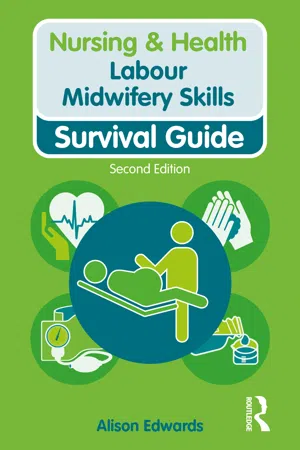
This is a test
- 68 pages
- English
- ePUB (mobile friendly)
- Available on iOS & Android
eBook - ePub
Book details
Book preview
Table of contents
Citations
About This Book
This pocket-sized book, presented in an easy-to-follow format, is designed as a tool for students and professionals to carry in any setting, providing a quick reference guide to supporting women during labour. Used as a platform for wider reading, this text is an ideal reference point for any student or professional involved with the care of childbearing women.
Frequently asked questions
At the moment all of our mobile-responsive ePub books are available to download via the app. Most of our PDFs are also available to download and we're working on making the final remaining ones downloadable now. Learn more here.
Both plans give you full access to the library and all of Perlego’s features. The only differences are the price and subscription period: With the annual plan you’ll save around 30% compared to 12 months on the monthly plan.
We are an online textbook subscription service, where you can get access to an entire online library for less than the price of a single book per month. With over 1 million books across 1000+ topics, we’ve got you covered! Learn more here.
Look out for the read-aloud symbol on your next book to see if you can listen to it. The read-aloud tool reads text aloud for you, highlighting the text as it is being read. You can pause it, speed it up and slow it down. Learn more here.
Yes, you can access Labour Midwifery Skills by Alison Edwards in PDF and/or ePUB format, as well as other popular books in Medicina & Prestazione di assistenza sanitaria. We have over one million books available in our catalogue for you to explore.
Information
Contents
- LIST OF FIGURES
- LIST OF TABLES
- LIST OF ABBREVIATIONS
- ANATOMY
- Pelvic floor
- Pelvis (gynaecoid)
- Bones
- Joints
- Ligaments
- The landmarks of the brim
- Placenta and membranes
- APGAR SCORES
- BIRTH ENVIRONMENT – PROMOTING NORMALITY
- BLOOD VALUES
- Electrolytes
- Blood gases
- Thyroid function tests
- Haematology
- CAESAREAN SECTION (LSCS)
- Preparation
- CATHETERISATION
- Procedure
- Alert
- Follow-up care after insertion of catheter
- Removal
- Follow-up care after removal
- CORD BLOODS
- CORD CLAMPING
- CTG INTERPRETATION
- DIABETIC WOMEN IN LABOUR
- After birth
- EXTERNAL CEPHALIC VERSION (ECV)
- Procedure
- EMERGENCIES
- Shoulder dystocia
- Post-partum haemorrhage
- Neonatal resuscitation
- Breech
- Cord prolapse
- Bladder filling
- EMERGENCY BIRTH
- EPIDURALS
- Advantages of an epidural
- Disadvantages of an epidural
- Procedure
- Epidural equipment
- Care of a woman with an epidural in situ
- EPISIOTOMY
- Procedure
- EXAMINATION OF THE PLACENTA
- FETAL BLOOD SAMPLING
- Equipment
- Procedure
- HOME BIRTH PREPARATION
- INITIAL BABY CHECK
- INSTRUMENTAL BIRTH
- Preparation
- MECHANISM OF NORMAL LABOUR (LOA)
- MONITORING MATERNAL AND FETAL WELL-BEING IN LABOUR
- Additional care may include:
- OBESITY AND LABOUR
- PAIN RELIEF
- Non-pharmacological
- Pharmacological
- PERINEAL REPAIR
- Degrees of perineal trauma
- Process
- POSITIONS FOR LABOUR AND BIRTH
- Positions for first stage of labour
- RESUSCITATION EQUIPMENT
- Neonatal bag and mask
- SBAR HANDOVER
- SIGNS OF TRANSITION
- STAGES AND PHASES OF LABOUR
- THIRD-STAGE MANAGEMENT
- Physiological/expectant
- Active
- VAGINAL EXAMINATION
- Documenting a vaginal examination
- VAGINAL BIRTH AFTER CAESAREAN (VBAC)
- Signs of rupture
- WATERBIRTH
- REFERENCES
While effort has been made to ensure that the content of this guide is accurate, no responsibility will be taken for inaccuracies, omissions or errors. This is a guide only. The information is provided solely on the basis that readers will be responsible for making their own assessment and adhering to organisation policy of the matters discussed therein. The author does not accept liability to any person for the information obtained from this publication or loss or damages incurred as a result of reliance upon the material contained in this guide.
Table of contents
- Cover
- Title Page
- Copyright Page
- Contents
- LIST OF FIGURES
- LIST OF TABLES
- LIST OF ABBREVIATIONS
- ANATOMY
- APGAR SCORES
- BIRTH ENVIRONMENT – PROMOTING NORMALITY
- BLOOD VALUES
- CAESAREAN SECTION (LSCS)
- CATHETERISATION
- CORD BLOODS
- CORD CLAMPING
- CTG INTERPRETATION
- DIABETIC WOMEN IN LABOUR
- EXTERNAL CEPHALIC VERSION (ECV)
- EMERGENCIES
- EMERGENCY BIRTH
- EPIDURALS
- EPISIOTOMY
- EXAMINATION OF THE PLACENTA
- FETAL BLOOD SAMPLING
- HOME BIRTH PREPARATION
- INITIAL BABY CHECK
- INSTRUMENTAL BIRTH
- MECHANISM OF NORMAL LABOUR (LOA)
- MONITORING MATERNAL AND FETAL WELL-BEING IN LABOUR
- OBESITY AND LABOUR
- PAIN RELIEF
- PERINEAL REPAIR
- POSITIONS FOR LABOUR AND BIRTH
- RESUSCITATION EQUIPMENT
- SBAR HANDOVER
- SIGNS OF TRANSITION
- STAGES AND PHASES OF LABOUR
- THIRD-STAGE MANAGEMENT
- VAGINAL EXAMINATION
- VAGINAL BIRTH AFTER CAESAREAN (VBAC)
- WATERBIRTH
- REFERENCES